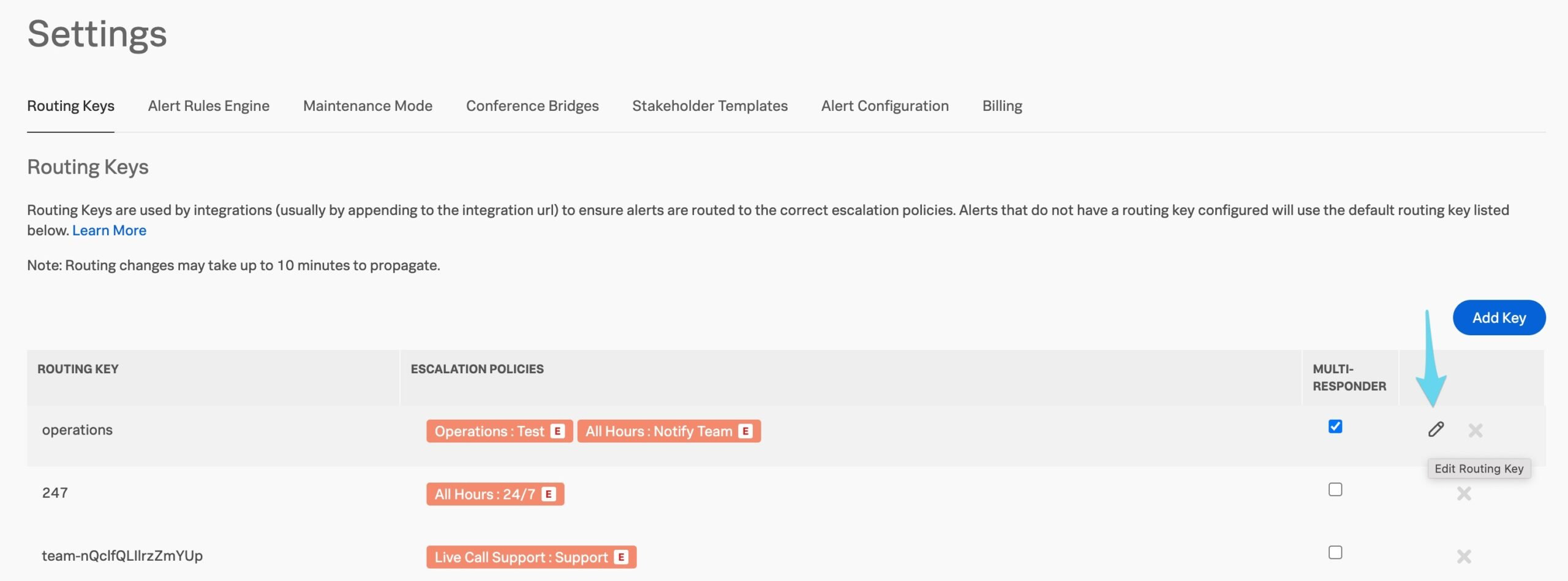Splunk On-Callでルーティングキーを作成する 🔗
アラートルーティングは、特定のタイプのアラートを特定のグループに割り当てるために必要な精度を提供します。チーム全体に不必要に通知することなく、特定のインシデントに対処するために、迅速かつ正確に特定のチームメンバーをターゲットにすることを目的とする場合、ルーティングキーが使用するツールです。
注釈
ルーティングキーは大文字小文字を区別せず、アルファベット、数字、ハイフン、アンダースコアのみで構成される必要があります。
グローバル管理者とアラート管理者は、Settings、Routing Keys の順に移動して、ルーティングキーを作成および管理できます。チーム管理者とユーザーは、ルーティングキーのみを表示できます。
Splunk On-Callでのルーティングキーの作成 🔗
Settings、Routing Keys の順にナビゲートした後、Add key ボタンを選択すると、新しいルーティングキーを作成できます。ルーティングキーに名前を付け、マルチ対応者 機能を呼び出すかどうかを指定し、ルーティングキーを少なくとも1つのエスカレーションポリシーに割り当てます。
マルチ対応者によるインシデント対応 🔗
ルーティングキーは、1回の承認でインシデントを完全に確認するか、定義された各エスカレーションポリシーのメンバーが最初に確認する必要があるかを定義する機能を提供します。
ルーティングキーの「マルチ対応者」ボックスがチェックされている場合、インシデントが完全に承認される前に、定義された各エスカレーションポリシーのメンバーからの承認が必要になります。既存のルーティングキーでこれを有効にするには、ルーティングキーの行にマウスを合わせ、表示される鉛筆アイコンをクリックします。「マルチ対応者」ボックスをチェックし、チェックマークを付けて変更を保存します。

Splunk On-Callでのルーティングルール 🔗
アラートがSplunk On-Callに配信されると、ルーティングルール( Settings、Routing Keys の表に示されています)によって、アラートやインシデントがどのチームにルーティングされるかが決定されます。インシデントが特定のエスカレーションポリシーにルーティングされると、そのエスカレーションポリシーが誰に通知するか、インシデントが未承認のままである場合に誰にエスカレーションするかを決定します。アラートのルーティングキーは、インテグレーションのモニタリングツール設定で指定され、インテグレーション設定内で判断できます。
アラートのルーティングキーを探す 🔗
すべてのタイプのアラートには、アラートを送信した監視ツールのインテグレーションを設定したユーザーによって割り当てられたルーティングキーがあります。これは、アラートをエスカレーションポリシーにマッピングするために使用されるキーです(前述のとおり)。アラートのルーティングキーを見つけるには、該当するアラートのアラート詳細をクリックします。VictorOps Fields セクションの下のキー/値のリストにルーティングキーが表示されます。
ルーティングキーのヒントとコツ 🔗
各チームは、他のチームと共有しない1つのルーティングキーを持つ必要があります。また、ルーティングキーにそれぞれのチーム名を付けることで、混乱を避けることができます。
ルーティングキーの名前はシンプルにしてください。キーに直感的な名前をつけることで、そのキーがどのチームと関連しているかが一目瞭然になります。
よくできたルーティングキーのセットでは、タイムラインの フィルターリング が簡単になります。フィルターリングされたタイムラインは、重要なイベントだけに焦点を絞る最も簡単な方法です。
複数のグループが特定のルーティングキーのインシデントを確認することが重要な場合は、ルーティングキーの行で Multi-Responder。すると、定義された各エスカレーションポリシーから承認が要求されます。